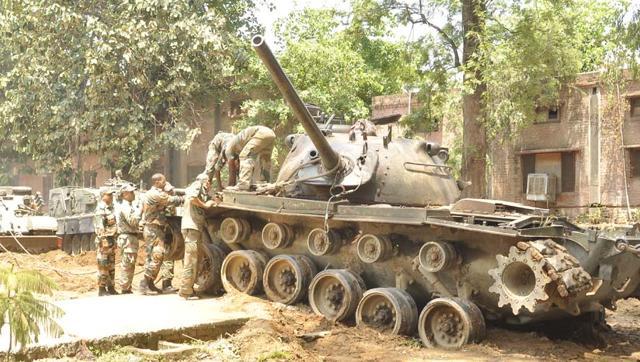The Punjab government had placed a 1971 Patton tank in Nehru Park as a “shaheedi samarak” – a memorial – to honor the 1965 Indo-Pak war hero Abdul Hamid in his hometown in Gurdaspur.
Raman Bahl had been the president of the Gurdaspur municipal council from 1992-97 and 2002-07 and was critical of the municipal council for not caring for the memorial. A year ago, the municipal council decided to turn the park into a parking lot. Local MLA Gurbachan Singh Babbehali was instrumental in getting the decision for a parking lot because of its proximity to the main markets in town.
Over the years most of the parts of the tank have been stolen, and the tank is in a dilapidated condition. The tank has sunk into the ground. When the Indian Army removed the tank last week, the treads fell off.
It was in 1965 that a full-scale war broke out, between Inda and Pakistan. Pakistan planned to take Amritsar and attempt to block supplies to the Indian Army stationed Jammu and Kashmir. They sought to take a bridge over the River Beas on the road to Jalandhar, which would prevent any supplies getting through.
The General of the Pakistani troops gave the orders to the 1st Armored Division. They immediately took Khem Karan, a town around five kilometers from the border.
As the attack took place Indian troops fell back and took a defensive position at the village of Asal Uttar, not far from Amritsar, from which they could attack the enemy.
The Pakistani tank division was more technologically advanced than the Indian troops and were advancing in over 300 US-produced tanks M-47 and M-48 Patton tanks. Meanwhile, the Indians had less than half the same number of tanks and which were older, Sherman Tanks made during World War Two.
The Pakistanis had a false sense of security as they advanced towards Amritsar. But the Indian Army had flooded the nearby sugar cane fields with water in order to slow the advancing Pakistani tanks. It was then that they launched a massive counterattack.
The battle is now known as the ‘Battle of Asal Uttar.’ The Indian Army ended up annihilating the entire Pakistani 1st Armoured Division leaving behind a field of destroyed tanks.
One of the Indian soldiers, Quarter Master Havildar Abdul Hamid who was fighting with the Four Grenadiers Battalion single-handedly took our four enemy tanks and stopped them from advancing. As the enemy tanks tried to drive through and past the Indian defences Hamid took out three more tanks.
Hamid was killed during the battle but was posthumously awarded the Param Vir Chakra, India’s highest military honor.
Military historians view the Battle of Asal Uttar as a pivotal point in the war of 1965 war, of which Pakistan never fully recovered.
